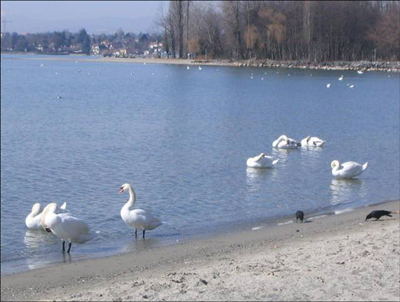Microbiological and chemical aspects in a freshwater heavily contaminated site
Microbiological and chemical aspects in a heavily contaminated site: case of the Bay of Vidy (Lake Geneva).

Description : Lake Geneva is the Western Europe’s largest freshwater reservoir with a surface area of 580 km2, a volume of 89 km3 and a maximum depth of 309 m. Approximately 700,000 people are supplied by this resource. Lausanne, a city of 127,000 inhabitants on the northern lake shore, pumps 58% of its water supply from the lake. It is also the city discharging the largest volumes of treated domestic and industrial wastewater into the nearby Bay of Vidy.
Since 1964, the sewage treatment plant of Vidy collects waste waters from the city of Lausanne and its neighbouring municipalities and treats approximately 1 to 3 m3/s. Effluent waters are released into the bay via an underwater pipe at 30 m water depth and at a distance of 700 m from the shore. Accumulation of heavy metals, organic substances and nutrients in the Bay of Vidy and its related ecological impacts and health risks have already been demonstrated in previous studies undertaken by the Institute F.-A. Forel (Loizeau et al., 2004; Pardos et al., 2004; Poté et al., 2008).
The high concentrations of organic matter are at the origin of reductive conditions at the sediment-water interface. This state is reflected by the presence of a microbial mat. These mats, or biofilms, develop in general according to chemical gradients.
Main objectives of the study :
- Identification and comparison of bacterial communities living in polluted sediments of the Bay of Vidy with non-polluted sediments, using molecular approaches. Characterization of micro-organisms present in the sediments and assessment of biodiversiy.
- Distribution of pathogenic bacteria in the water column and the sediments, using faecal indicator bacteria (FIB) and standard cultivation techniques.
- Importance of FIB survival and growth in sediments, according to different environmental parameters (such as nutrients and temperature).
- Assessment of relationships between environmental parameters and microbiological diversity in sediments.
- Evaluation of bacterial activities in relation to chemical characteristics and micro-pollutants.
Framework/Financing : F.-A. Forel Institute, University of Geneva.
Collaborations : : Instituto cantonale di microbiologia, Bellinzona and University of Neuchâtel.
Supervisors and colleagues directly involved :
Ph.D. supervisor : Professor Walter Wildi and Dr. John Poté (University of Geneva).
Ph.D. Co-Direction of thesis and partnership : Professor Raffaele Peduzzi, Dr. Mauro Tonolla (Instituto cantonale di microbiologia, Bellinzona) and Dr. Jakob Zopfi (University of Neuchâtel).
Collaboratrice involved: Laurence HALLER
